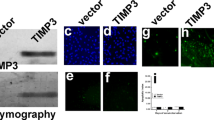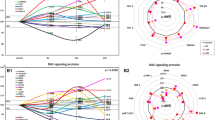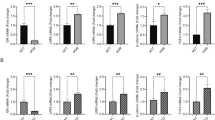Abstract
Osteoprotegerin (OPG) a soluble tumor necrosis factor receptor family molecule protects endothelial cells from apoptosis in vitro and promotes neovascularization in vivo. In this study, we assessed the role of OPG and its ligands, receptor activator of nuclear factor-κB ligand (RANKL) and tumor necrosis factor-related apoptosis inducing ligand (TRAIL), in microvessel formation using the rat aortic ring model of angiogenesis. OPG was found to promote a twofold increase in angiogenic sprouting in the aortic ring model, and this effect was inhibited by pre-incubation with a fivefold molar excess of either RANKL or TRAIL. While TRAIL had no effect upon angiogenesis on its own, RANKL was found to potently inhibit basal and vascular endothelial growth factor-induced angiogenesis. OPG increased the rate of endothelial cell proliferation in sprouting microvessels; in contrast, RANKL inhibited proliferation. RANKL was found to induce endothelial apoptosis at days 6, 7, and 10 in the aortic ring model and after incubation with human umbilical vein endothelial cells (HUVECs). Signaling studies showed that OPG induced ERK1/2 and Akt phosphorylation in HUVECs while RANKL had no effect. Our results indicate that OPG is a positive regulator of microvessel formation, while RANKL is an angiogenic inhibitor due to effects on regulation of endothelial cell proliferation, apoptosis, and signaling.







Similar content being viewed by others
References
Gasparini G, Longo R, Toi M, Ferrara N (2005) Angiogenic inhibitors: a new therapeutic strategy in oncology. Nat Clin Pract Oncol 2:562–577. doi:10.1038/ncponc0342
Annex BH, Simons M (2005) Growth factor-induced therapeutic angiogenesis in the heart: protein therapy. Cardiovasc Res 65:649–655. doi:10.1016/j.cardiores.2004.09.004
Patel ZS, Mikos AG (2004) Angiogenesis with biomaterial-based drug- and cell-delivery systems. J Biomater Sci Polym Ed 15:701–726. doi:10.1163/156856204774196117
Ratner BD (2002) Reducing capsular thickness and enhancing angiogenesis around implant drug release systems. J Control Release 78:211–218. doi:10.1016/S0168-3659(01)00502-8
Simonet WS, Lacey DL, Dunstan CR, Kelley M, Chang MS, Luthy R, Nguyen HQ, Wooden S, Bennett L, Boone T et al (1997) Osteoprotegerin: a novel secreted protein involved in the regulation of bone density. Cell 89:309–319. doi:10.1016/S0092-8674(00)80209-3
Tsuda E, Goto M, Mochizuki S, Yano K, Kobayashi F, Morinaga T, Higashio K (1997) Isolation of a novel cytokine from human fibroblasts that specifically inhibits osteoclastogenesis. Biochem Biophys Res Commun 234:137–142. doi:10.1006/bbrc.1997.6603
Hofbauer LC (1999) Osteoprotegerin ligand and osteoprotegerin: novel implications for osteoclast biology and bone metabolism. Eur J Endocrinol 141:195–210. doi:10.1530/eje.0.1410195
Hofbauer LC, Khosla S, Dunstan CR, Lacey DL, Boyle WJ, Riggs BL (2000) The roles of osteoprotegerin and osteoprotegerin ligand in the paracrine regulation of bone resorption. J Bone Miner Res 15:2–12. doi:10.1359/jbmr.2000.15.1.2
Lacey DL, Timms E, Tan HL, Kelley MJ, Dunstan CR, Burgess T, Elliott R, Colombero A, Elliott G, Scully S et al (1998) Osteoprotegerin ligand is a cytokine that regulates osteoclast differentiation and activation. Cell 93:165–176. doi:10.1016/S0092-8674(00)81569-X
Wong BR, Rho J, Arron J, Robinson E, Orlinick J, Chao M, Kalachikov S, Cayani E, Bartlett FS 3rd, Frankel WN et al (1997) TRANCE is a novel ligand of the tumor necrosis factor receptor family that activates c-Jun N-terminal kinase in T cells. J Biol Chem 272:25190–25194. doi:10.1074/jbc.272.40.25190
Anderson DM, Maraskovsky E, Billingsley WL, Dougall WC, Tometsko ME, Roux ER, Teepe MC, DuBose RF, Cosman D, Galibert L (1997) A homologue of the TNF receptor and its ligand enhance T-cell growth and dendritic-cell function. Nature 390:175–179. doi:10.1038/36593
Abe K, Kurakin A, Mohseni-Maybodi M, Kay B, Khosravi-Far R (2000) The complexity of TNF-related apoptosis-inducing ligand. Ann N Y Acad Sci 926:52–63
Emery JG, McDonnell P, Burke MB, Deen KC, Lyn S, Silverman C, Dul E, Appelbaum ER, Eichman C, DiPrinzio R et al (1998) Osteoprotegerin is a receptor for the cytotoxic ligand TRAIL. J Biol Chem 273:14363–14367. doi:10.1074/jbc.273.23.14363
Yun TJ, Chaudhary PM, Shu GL, Frazer JK, Ewings MK, Schwartz SM, Pascual V, Hood LE, Clark EA (1998) OPG/FDCR-1, a TNF receptor family member, is expressed in lymphoid cells and is up-regulated by ligating CD40. J Immunol 161:6113–6121
Yasuda H, Shima N, Nakagawa N, Yamaguchi K, Kinosaki M, Mochizuki S, Tomoyasu A, Yano K, Goto M, Murakami A et al (1998) Osteoclast differentiation factor is a ligand for osteoprotegerin/osteoclastogenesis-inhibitory factor and is identical to TRANCE/RANKL. Proc Natl Acad Sci USA 95:3597–3602. doi:10.1073/pnas.95.7.3597
Bucay N, Sarosi I, Dunstan CR, Morony S, Tarpley J, Capparelli C, Scully S, Tan HL, Xu W, Lacey DL et al (1998) Osteoprotegerin-deficient mice develop early onset osteoporosis and arterial calcification. Genes Dev 12:1260–1268. doi:10.1101/gad.12.9.1260
Mizuno A, Amizuka N, Irie K, Murakami A, Fujise N, Kanno T, Sato Y, Nakagawa N, Yasuda H, Mochizuki S et al (1998) Severe osteoporosis in mice lacking osteoclastogenesis inhibitory factor/osteoprotegerin. Biochem Biophys Res Commun 247:610–615. doi:10.1006/bbrc.1998.8697
Kong YY, Yoshida H, Sarosi I, Tan HL, Timms E, Capparelli C, Morony S, Oliveira-dos-Santos AJ, Van G, Itie A et al (1999) OPGL is a key regulator of osteoclastogenesis, lymphocyte development and lymph-node organogenesis. Nature 397:315–323. doi:10.1038/16852
Dougall WC, Glaccum M, Charrier K, Rohrbach K, Brasel K, De Smedt T, Daro E, Smith J, Tometsko ME, Maliszewski CR et al (1999) RANK is essential for osteoclast and lymph node development. Genes Dev 13:2412–2424. doi:10.1101/gad.13.18.2412
Zannettino AC, Holding CA, Diamond P, Atkins GJ, Kostakis P, Farrugia A, Gamble J, To LB, Findlay DM, Haynes DR (2005) Osteoprotegerin (OPG) is localized to the Weibel–Palade bodies of human vascular endothelial cells and is physically associated with von Willebrand factor. J Cell Physiol 204:714–723. doi:10.1002/jcp.20354
Bennett BJ, Scatena M, Kirk EA, Rattazzi M, Varon RM, Averill M, Schwartz SM, Giachelli CM, Rosenfeld ME (2006) Osteoprotegerin inactivation accelerates advanced atherosclerotic lesion progression and calcification in older ApoE−/− mice. Arterioscler Thromb Vasc Biol 26:2117–2124. doi:10.1161/01.ATV.0000236428.91125.e6
Morony S, Tintut Y, Zhang Z, Cattley RC, Van G, Dwyer D, Stolina M, Kostenuik PJ, Demer LL (2008) Osteoprotegerin inhibits vascular calcification without affecting atherosclerosis in ldlr(−/−) mice. Circulation 117:411–420. doi:10.1161/CIRCULATIONAHA.107.707380
Kiechl S, Schett G, Wenning G, Redlich K, Oberhollenzer M, Mayr A, Santer P, Smolen J, Poewe W, Willeit J (2004) Osteoprotegerin is a risk factor for progressive atherosclerosis and cardiovascular disease. Circulation 109:2175–2180. doi:10.1161/01.CIR.0000127957.43874.BB
Schoppet M, Sattler AM, Schaefer JR, Hofbauer LC (2006) Osteoprotegerin (OPG) and tumor necrosis factor-related apoptosis-inducing ligand (TRAIL) levels in atherosclerosis. Atherosclerosis 184:446–447. doi:10.1016/j.atherosclerosis.2005.10.028
Soufi M, Schoppet M, Sattler AM, Herzum M, Maisch B, Hofbauer LC, Schaefer JR (2004) Osteoprotegerin gene polymorphisms in men with coronary artery disease. J Clin Endocrinol Metab 89:3764–3768. doi:10.1210/jc.2003-032054
Ziegler S, Kudlacek S, Luger A, Minar E (2005) Osteoprotegerin plasma concentrations correlate with severity of peripheral artery disease. Atherosclerosis 182:175–180
Malyankar UM, Scatena M, Suchland KL, Yun TJ, Clark EA, Giachelli CM (2000) Osteoprotegerin is an alpha vbeta 3-induced, NF-kappa B-dependent survival factor for endothelial cells. J Biol Chem 275:20959–20962. doi:10.1074/jbc.C000290200
Scatena M, Giachelli C (2002) The alpha(v)beta3 integrin, NF-kappaB, osteoprotegerin endothelial cell survival pathway. Potential role in angiogenesis. Trends Cardiovasc Med 12:83–88. doi:10.1016/S1050-1738(01)00151-7
Pritzker LB, Scatena M, Giachelli CM (2004) The role of osteoprotegerin and tumor necrosis factor-related apoptosis-inducing ligand in human microvascular endothelial cell survival. Mol Biol Cell 15:2834–2841. doi:10.1091/mbc.E04-01-0059
Myers DE, Collier FM, Minkin C, Wang H, Holloway WR, Malakellis M, Nicholson GC (1999) Expression of functional RANK on mature rat and human osteoclasts. FEBS Lett 463:295–300. doi:10.1016/S0014-5793(99)01650-6
Zhu WH, Nicosia RF (2002) The thin prep rat aortic ring assay: a modified method for the characterization of angiogenesis in whole mounts. Angiogenesis 5:81–86. doi:10.1023/A:1021509004829
Zhu WH, MacIntyre A, Nicosia RF (2002) Regulation of angiogenesis by vascular endothelial growth factor and angiopoietin-1 in the rat aorta model: distinct temporal patterns of intracellular signaling correlate with induction of angiogenic sprouting. Am J Pathol 161:823–830
Cross SS, Yang Z, Brown NJ, Balasubramanian SP, Evans CA, Woodward JK, Neville-Webbe HL, Lippitt JM, Reed MW, Coleman RE et al (2006) Osteoprotegerin (OPG)—a potential new role in the regulation of endothelial cell phenotype and tumour angiogenesis? Int J Cancer 118:1901–1908. doi:10.1002/ijc.21606
Bharti AC, Aggarwal BB (2004) Ranking the role of RANK ligand in apoptosis. Apoptosis 9:677–690. doi:10.1023/B:APPT.0000045780.10463.c6
Bharti AC, Takada Y, Shishodia S, Aggarwal BB (2004) Evidence that receptor activator of nuclear factor (NF)-kappaB ligand can suppress cell proliferation and induce apoptosis through activation of a NF-kappaB-independent and TRAF6-dependent mechanism. J Biol Chem 279:6065–6076. doi:10.1074/jbc.M308062200
Kim HH, Shin HS, Kwak HJ, Ahn KY, Kim JH, Lee HJ, Lee MS, Lee ZH, Koh GY (2003) RANKL regulates endothelial cell survival through the phosphatidylinositol 3′-kinase/Akt signal transduction pathway. FASEB J 17:2163–2165
Kim YM, Lee YM, Kim HS, Kim JD, Choi Y, Kim KW, Lee SY, Kwon YG (2002) TNF-related activation-induced cytokine (TRANCE) induces angiogenesis through the activation of Src and phospholipase C (PLC) in human endothelial cells. J Biol Chem 277:6799–6805. doi:10.1074/jbc.M109434200
Alladina SJ, Song JH, Davidge ST, Hao C, Easton AS (2005) TRAIL-induced apoptosis in human vascular endothelium is regulated by phosphatidylinositol 3-kinase/Akt through the short form of cellular FLIP and Bcl-2. J Vasc Res 42:337–347. doi:10.1159/000086599
Cantarella G, Risuglia N, Dell’eva R, Lempereur L, Albini A, Pennisi G, Scoto GM, Noonan DN, Bernardini R (2006) TRAIL inhibits angiogenesis stimulated by VEGF expression in human glioblastoma cells. Br J Cancer 94:1428–1435. doi:10.1038/sj.bjc.6603092
Li JH, Kirkiles-Smith NC, McNiff JM, Pober JS (2003) TRAIL induces apoptosis and inflammatory gene expression in human endothelial cells. J Immunol 171:1526–1533
Secchiero P, Gonelli A, Carnevale E, Corallini F, Rizzardi C, Zacchigna S, Melato M, Zauli G (2004) Evidence for a proangiogenic activity of TNF-related apoptosis-inducing ligand. Neoplasia 6:364–373. doi:10.1593/neo.03421
Secchiero P, Gonelli A, Carnevale E, Milani D, Pandolfi A, Zella D, Zauli G (2003) TRAIL promotes the survival and proliferation of primary human vascular endothelial cells by activating the Akt and ERK pathways. Circulation 107:2250–2256. doi:10.1161/01.CIR.0000062702.60708.C4
Auerbach R, Lewis R, Shinners B, Kubai L, Akhtar N (2003) Angiogenesis assays: a critical overview. Clin Chem 49:32–40. doi:10.1373/49.1.32
Nicosia RF, Lin YJ, Hazelton D, Qian X (1997) Endogenous regulation of angiogenesis in the rat aorta model. Role of vascular endothelial growth factor. Am J Pathol 151:1379–1386
Villaschi S, Nicosia RF (1993) Angiogenic role of endogenous basic fibroblast growth factor released by rat aorta after injury. Am J Pathol 143:181–190
Ferrari G, Pintucci G, Seghezzi G, Hyman K, Galloway AC, Mignatti P (2006) VEGF, a prosurvival factor, acts in concert with TGF-beta1 to induce endothelial cell apoptosis. Proc Natl Acad Sci USA 103:17260–17265. doi:10.1073/pnas.0605556103
Segura I, Serrano A, De Buitrago GG, Gonzalez MA, Abad JL, Claveria C, Gomez L, Bernad A, Martinez AC, Riese HH (2002) Inhibition of programmed cell death impairs in vitro vascular-like structure formation and reduces in vivo angiogenesis. FASEB J 16:833–841. doi:10.1096/fj.01-0819com
Fierlbeck W, Liu A, Coyle R, Ballermann BJ (2003) Endothelial cell apoptosis during glomerular capillary lumen formation in vivo. J Am Soc Nephrol 14:1349–1354. doi:10.1097/01.ASN.0000061779.70530.06
Haynes DR, Barg E, Crotti TN, Holding C, Weedon H, Atkins GJ, Zannetino A, Ahern MJ, Coleman M, Roberts-Thomson PJ et al (2003) Osteoprotegerin expression in synovial tissue from patients with rheumatoid arthritis, spondyloarthropathies and osteoarthritis and normal controls. Rheumatology (Oxford) 42:123–134. doi:10.1093/rheumatology/keg047
Collin-Osdoby P, Rothe L, Anderson F, Nelson M, Maloney W, Osdoby P (2001) Receptor activator of NF-kappa B and osteoprotegerin expression by human microvascular endothelial cells, regulation by inflammatory cytokines, and role in human osteoclastogenesis. J Biol Chem 276:20659–20672. doi:10.1074/jbc.M010153200
Jono S, Ikari Y, Shioi A, Mori K, Miki T, Hara K, Nishizawa Y (2002) Serum osteoprotegerin levels are associated with the presence and severity of coronary artery disease. Circulation 106:1192–1194. doi:10.1161/01.CIR.0000031524.49139.29
Acknowledgments
Funding support was received from the NSF (NSF-EEC-9872882 to CMG and MS) and from the NIH (NIH-HL-018645-29 to CMG and MS, NIH/NRSA-5T32GM065098 to JSM, and AHA 0655677Z to MS).
Author information
Authors and Affiliations
Corresponding author
Rights and permissions
About this article
Cite this article
McGonigle, J.S., Giachelli, C.M. & Scatena, M. Osteoprotegerin and RANKL differentially regulate angiogenesis and endothelial cell function. Angiogenesis 12, 35–46 (2009). https://doi.org/10.1007/s10456-008-9127-z
Received:
Accepted:
Published:
Issue Date:
DOI: https://doi.org/10.1007/s10456-008-9127-z




